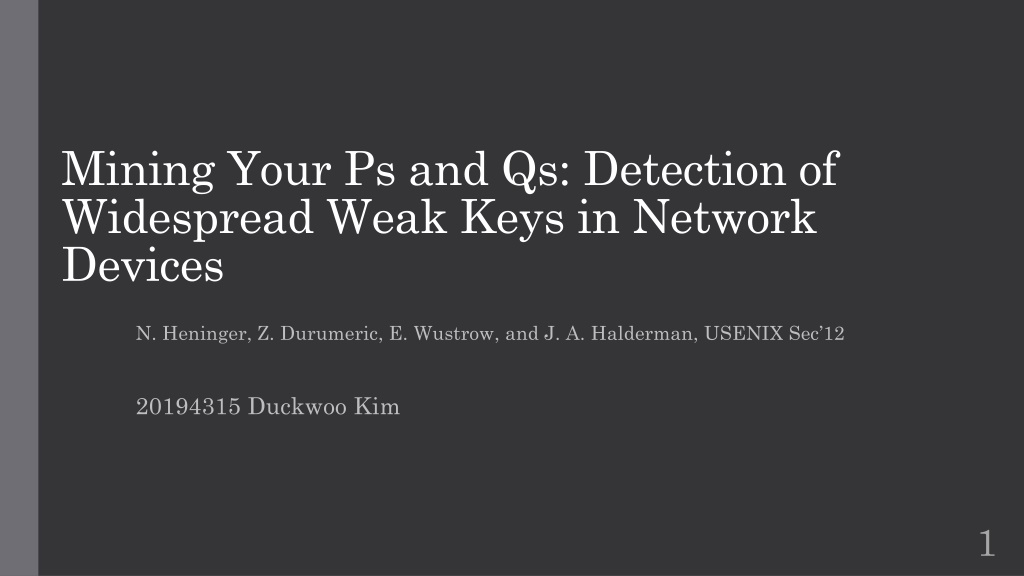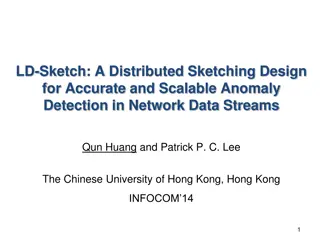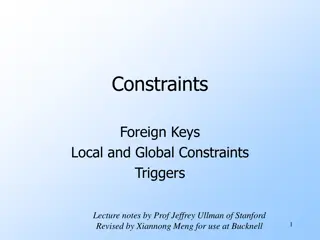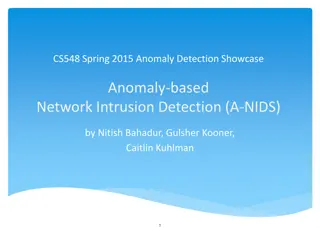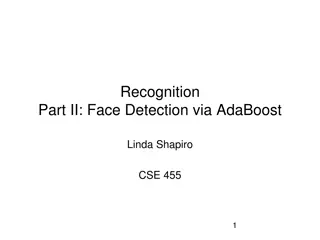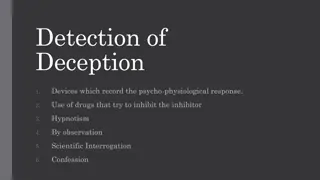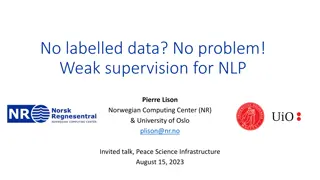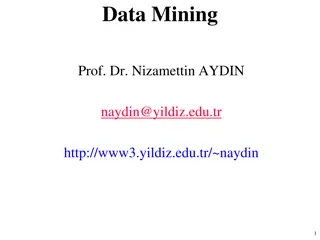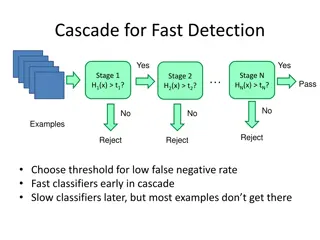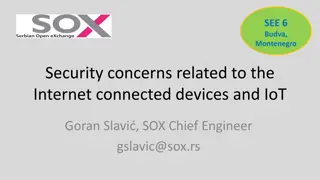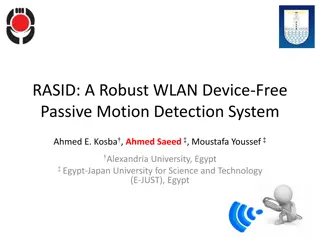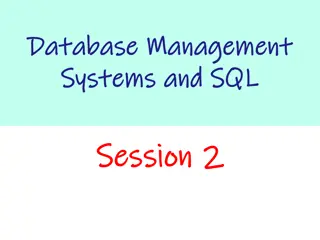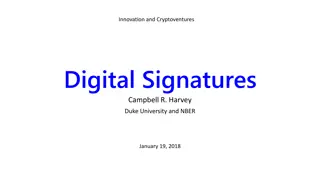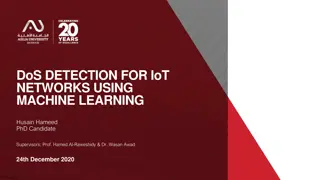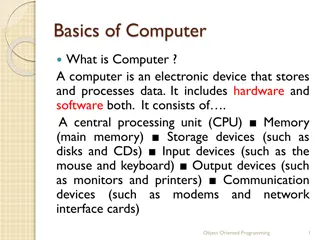Weak Keys Detection in Network Devices
TLS and SSH rely on RSA and DSA for security, but weaknesses in random number generation can lead to widespread weak keys among hosts on the Internet. This paper uncovers the prevalence of repeated keys and easily inferred private keys, emphasizing the importance of entropy pools in key generation. The experiment setup involved using Nmap and Amazon EC2 instances to scan for RSA and DSA keys, with results highlighting potential vulnerabilities. Additionally, the overview of RSA shows the risks of insecure key pairs and strategies to enhance security against factorization attacks.
Download Presentation

Please find below an Image/Link to download the presentation.
The content on the website is provided AS IS for your information and personal use only. It may not be sold, licensed, or shared on other websites without obtaining consent from the author. Download presentation by click this link. If you encounter any issues during the download, it is possible that the publisher has removed the file from their server.
E N D
Presentation Transcript
Mining Your Ps and Qs: Detection of Widespread Weak Keys in Network Devices N. Heninger, Z. Durumeric, E. Wustrow, and J. A. Halderman, USENIX Sec 12 20194315 Duckwoo Kim 1
Paper Summary TLS and SSH use RSA and DSA, which is very secure unless RNG (random number generator) malfunctions Are all hosts over Internet correctly generating their keys? 2
Paper Summary No! There are mainly 2 problems: Repeated keys among multiple hosts- 5.57% of TLS-using hosts, 9.6% of SSH-using Easily inferred private keys - 0.5% of TLS-using hosts, 1.06% of SSH-using private key = d public key = (e, N) private key = d public key = (e , N ) private key = d public key = (e, N) d is ### Why? How to defense? * entropy pool is important 3
Experiment Setup Finding all hosts over Internet Use Nmap Use 25 Amazon EC2 Micro, spread across worldwide Take ~25 hours Retrieving certificate and public keys Multiple run which target RSA-based keys, and DSA-based keys In RSA, parse the certificate chain Also get signature when DSA run Store into database, investigate them 4
Experiment Result ? ? ? ? 6
RSA Overview RSA use two random prime number (p, q) Public key: ?,? , ? = ?? Private key: ? = ? 1 ???(? 1)(? 1) It is very hard to factorize large ? into ? and ? Note: Computing ??? ?1,?2 is very fast 7
RSA may not be Secure If ?1= ??1,?2= ??2, then ??? ?1,?2 = ? 1 We can factorize both ?1 and ?2! Getting ??? ?1,?2 takes ~15us However Pr(??? ?1,?2 1) is very small Attacker should consider all possible pairs (??, ??) for ? < ? < ? There are 6 1013pairs in gathered dataset It takes ~30 years How to reduce the computation time? 8
RSA may not be Secure Use a Bernstein algorithm: 1. Compute ? = ?? 2. Compute ??= ? ?????2 3. if ??? ??,?? ~O(n) time complexity 1? ?? e.g. (vulnerable case) put ?1= ??1?2= ??2 P = ?2?1?2 ?1= ?2?1? + ??1??? ?2?12 = ?2?1? (?<?1) ??? ?1,?1 ?1 = ??? ??1,?? = ? 9
DSA (digital signature algorithm) Overview DSA use two random prime number (p, q) + one more random number ? as ephemeral key Public key: ?,?,?,? , ? = ????? ?, ? is made from ? ??? ? Private key: ?,? , ? is ???? ????, and ? is ?? ?????? ??? Signature: (?,?), ? = ????? ? ??? ?, ? = ? 1? ? + ?? ??? ? It is very hard to infer ? or ? from public key and signature 10
DSA may not be Secure If multiple signature with same ephemeral key k Generate (?1,?1), (?2,?2) using same ?,? ?1= ?2= ????? ? ??? ? ? ?1 ??1 ?? ??? ?, ? ?2 ??2 ?? ??? ? ? = ? 1? ? + ?? ??? ? ?? ? ? + ?? ??? ? (?1 ?2) 1??? ? ? = ? ?1 ? ?2 ? =? 1?? ? ? ??? ? ? = ? 1? ? + ?? ??? ? Summary: same public key, same ? private key exposed 11
Randomness is very Important In RSA, all ?,? must not be duplicated when generated Also, the key itself should not be different to other hosts In DSA, random number ? should not be reused N = pq N = pq N = p q N = pq public key = (e, N) public key = (e , N ) public key = (e , N ) public key = (e, N) How to ensure randomness ? 12
How to Ensure Randomness? Entropy: the randomness collected by an operating system or by an application (e.g. OpenSSL, Dropbear) There are many entropy source that cannot be predictable User input (mouse/keyboard), disk access timing, noise, Kernel stores these entropy source into entropy pool mix Entropy Pool 13
How to Ensure Randomness? Kernel extract data from the pool to generate random num. Done by reading /dev/random or /dev/urandom If entropy pool is empty, then random will blocked, and wait until the pool is filled urandom will generate number anyway, with less randomness 14
Linux RNG (random number generator) Entropy counter block (when less entropy) 780 Fresh entropy extract read update Blocking pool /dev/random synchronous extract Input pool extract read Nonblocking pool /dev/urandom asynchronous extract Most use this 15
Linux RNG (random number generator) Entropy counter block (when less entropy) 10 Fresh entropy read /dev/random update Blocking pool X synchronous extract Input pool read /dev/urandom extract Nonblocking pool asynchronous extract Most use this 16
Experiment Result (again) 17 Main problem is lack of entropy!
Vulnerablities Lack of entropy in some timing at some devices Embedded and headless devices can t get entropy from user input Right after booting, there is entropy hole that machine didn t get enough entropy source During entropy hole, output of /dev/urandom is predictable and repeatable 18
Vulnerablities Lack of entropy in some timing at some devices Embedded and headless devices 19
Vulnerablities Applications does not work in secure well OpenSSL and Dropbear use their own entropy pool They first get a seed from Linux via /dev/urandom at launch If one generate multiple keys at same time, the random number may be repeated 20
Vulnerablities Applications does not work in secure well Note: In one host using RSA, repeated N is better than repeated p OpenSSL changes entropy pool in the middle of key generation First numbers are generated from same pool, and second from different Only one different Problematic! Both factor different Very good Both factor repeated Not bad 21
Vulnerablities Applications does not work in secure well 22
Defense Various fields of developers all need to be careful For OS developers: Don t abuse /dev/urandom But random is much worse, so maybe new operation is needed Consider various device, such as the headless and embedded 23
Defense Various fields of developers all need to be careful For library, app developers: Set default as the most secure configuration Dropbear has option that prevent repeated ephemeral key, but not default Use RSA and DSA defensively In RSA, make repeated key rather than repeated factor Generate keys in lazy manner, not on install or first boot 24
Defense Various fields of developers all need to be careful For device manufacturers: Add seed entropy at the factory Each device in same model get unique state Ensure sufficient entropy source Be aware of that embedded device are lack of source Add HRNG (hardware random number generator) chip 25
Defense Various fields of developers all need to be careful For certificate authorities: Check repeated, weak, factorable keys They can repeat our experiment For end users: Do not use default key Check for known weak keys 26
Related Works Other cryptographic vulnerabilities Unsecure ECDSA key Elliptic curve cryptography in practice. , FC 14 Diffie-Hellman algorithm Imperfect Forward Secrecy: How Diffie-Hellman Fails in Practice , CCS 15 Malfunction of RNG Security Analysis of Pseudo-Random Number Generators with Input: /dev/random is not Robust, CCS 13 Not-so-random numbers in virtualized Linux and the Whirlwind RNG, SP 14 27
Conclusion Insecure RNG makes TLS and SSH vulnerable There are already lots of vulnerable private keys throughout the Internet Simple scanning and analysis can find subtle flaws in cryptographic implementations This works are a reminder to everyone 28
